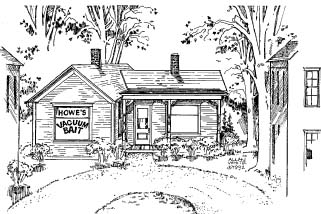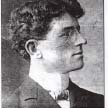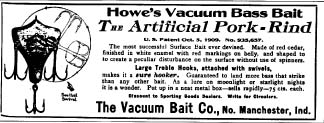
Copyright © 2009-2020
North Manchester
Historical Society
All rights reserved.
Please contact
our Center for History
if you find
inaccuracies or
inappropriate content.
|
|
Source: NMHS
Newsletter, May 2001LUME XVIII
NUMBER 2
MAY, 2001
|
|
 |
|
Drawing of the Howe Vacuum Bait
Company by Allan White, based on the memories of
Dr. L.Z. Bunker
|
|
The Howe Vacuum Bait Company
Presented by William R. Eberly to
the North Manchester Historical Society, March
12, 2001
Among the numerous unusual businesses that have
flourished in North Manchester in the past was a
company that manufactured artificial fishing
baits (called lures by the practitioners of the
art). The lure was designed to catch the common
bass, much sought by fishermen throughout the
country. Like the mythical "better mouse trap" a
better bass plug should be a hot item in bait
shops everywhere. And the North Manchester bass
bait seemed to make it to the top of the list
for awhile.
The Vacuum Bait was a triangular piece of
well-polished cedar
|
|
[Continued on Page Two] Page One
|
|
 |
 |
| wood
painted with bright colors to imitate various
natural food items of the bass. The fishing line
was attached at the wide end of the bait and
three sets of treble hooks were inserted along
the sides and end. The hooks were of a unique
patented design that would rotate freely in a
complete 360 degree circle. This was supposed to
prevent the fish from twisting itself free from
the hook. But now, back to the beginning of this
interesting story!
The inventor of the Vacuum Bait was Francis
O. Howe, commonly known as Frank. He was born in
Ohio in 1874 and came with his family to North
Manchester in 1889. His father was David N. Howe
who was the founder of the North Manchester
College which was later called simply Manchester
College. Frank would have been fifteen years old
at the time of the move and had several brothers
and sisters. Frank's mother died here and his
father later married two more times and had a
total of twenty children. Frank married in 1895
and remained in North Manchester after the Howes
moved away that same year. One of Frank's
children was Bruce Howe, a very colorful
character in North Manchester society for many
years.
Among other things, Frank Howe was a
musician, performing and teaching instrumental
music, especially piano and violin. He was
associated with Manchester College as a music
instructor, at least during 1899-1900. He was a
protégé of Maude Quivey, outstanding musician of
the community. At the memorial service, one of
his brothers said, "Some men are builders of
steel; others are strong on finance; some love
the gift of speech; but here was a man whose
soul was touched by music, the language of the
soul."
But Frank had at least two other qualities
often overlooked; he
|
|
 Francis
(Frank) O. Howe Francis
(Frank) O. Howe
1874-1924 |
|
| |
|
 |
|
Page Two
|
 |
 |
|
 |
|
loved to fish, and he was a man of some
mechanical and inventive talents. It seemed a
natural outcome of these two interests that he
would invent (and manufacture and sell) the
perfect bass bait. Working in his home in the
400 block of Walnut Street (across from the high
school, then) he made |
|
many of these baits for his own use and for his
friends, and eventually started to sell them.
The North Manchester Journal for May 13,
1909, declares that Frank O Howe "...has spent
more time in scientific fishing than any other
man in this part of the country in the past few
years. He has studied the habits of the fish,
and when he became interested in the bait
question he spent his time trying various baits,
and finding the weak places and how to remedy
them. The result is Howe's Vacuum Bait..."
His application for a patent was granted
October 5, 1909. He formed a partnership with
Charles H. Olinger and J. W. Warvel which was
incorporated in August of 1909. The capital
stock was $5,000 divided into 100 shares valued
at $50 each, all of which were owned by the
three partners. Demand for the bait (distributed
through dealers in the area) was so great that a
new location was soon needed. A room in a
building owned by Dr. J. L. Warvel was equipped
for the new factory. This was previously the
location of a bicycle repair shop


|
|
| |
| |
[Continued on Page Four] Page Three
|
|
| |
 |
 |
|
operated by Charles Olinger. Outgrowing that
location, Olinger, in partnership with Warvel,
went to a new location and soon moved into the
automotive business.
The building housing the new factory was a
frame house located just east of the Lutheran
Church and near the river, somewhat behind
another building in what is now the town parking
lot. Dr. L. Z. Bunker recalled this quite well.
Her father was a fisherman and used the bait and
Dr. Bunker herself had fished some and had used
the bait on occasion. In a phone conversation
with the writer on November 4, 1991, Dr. Bunker
described the bait with uncanny accuracy shape,
color, general texture of the surface, etc.
While I was talking with her, I had in front of
me one of the Howe baits. She knew just the main
color pattern, i.e., which was with red marks.
She described the red markings as if you took a
comma and straightened it out.
She described the factory as "an old house,
white, with a porch, located back of the Filling
Station, a restaurant located toward the west
side of what is not the parking lot and market."
The restaurant was subsequently operated by Paul
Hathaway and named the Flamingo Grill. A Mr. J.
J. Martin operated a photographic studio in this
complex of buildings. The house/factory could be
reached by a rambling walk around the west end
of the restaurant. With guidance from Dr.
Bunker, Mr. Allan White, an artist and designer
from North Manchester, created a drawing of the
Vacuum Bait factory.
For a while, at least, wood blanks were made
by the Caswell-Runyan company in Huntington, a
factory that made cedar chests. They would have
an abundance of scrap cedar wood from which to
make the bodies for the Vacuum Baits. It appears
that the fabrication of the special hooks was
done in the Manchester factory. Fred Horne, an
outstanding tool maker of North Manchester,
installed machinery (probably a multiple
automatic screw machine) in the new factory. It
is not known where the tin boxes that enclosed
the baits were made.
Business was very brisk for a number of
years. Bait stores and hardware stores sold the
baits almost as fast as they could be produced.
The baits came in two sizes and about 30 color
patterns, usually duplicated in both the large
and small sizes. The company advertised
extensively. Some of the brochures not only
described the various
|
|
Page Four
|
|
 |
 |
|
versions of the bait but also gave hints and
instructions for using it. Some ads contained
testimonies. "In about 2 hours casting with your
bait I landed 7 black bass, combined weight 22
lbs." "It is the King of all surface Lures."
"Was out May 21st, used four kinds and no
strikes, put on a Vacuum and caught 10. I
consider them a first class Bait." "On June
22nd, caught by actual count 50, largest 7
one-half lbs."
William E. Billings, writing about North
Manchester Industries, said, "Many fishermen
swore by it, and possibly some swore at it. Tom
Peabody, who always believed in efficiency,
brought a bait back one Monday morning with the
complaint that only two hooks were working, as
he could never catch more than two fish at a
time."
Eventually, though, the business folded.
Perhaps Olinger and Warvel felt they could make
more money in the automotive business. Maybe
Frank Howe's health even then was beginning to
fail. In about 1920, Howe sold his patent and a
quantity of unused parts for making the baits to
the South Bend Bait Company. It was first
advertised in their 1921 catalog and may have
been listed up into the 1940s. The South Bend
version differed slightly from the Howe version.
For one thing, the South Bend company put eyes
in their plugs. South Bend also used a more
simple hook attachment with the hook swinging
only in one plane. They continued almost the
same color patterns in both the large and small
sizes.
One can always identify a Vacuum Bait;
nothing else looks even remotely like it. But
they are scarce today. There is always a ready
buyer if one becomes available. The containers
(both tin and cardboard) are even more rare.
For North Manchester, the Vacuum Bait company
ranks right in there along with the DeWitt
Automobile, the Blackmore cigars, the bonnet
company, the instant water heater company, the
folding bathtub company, and other quaint and
unusual products manufactured in our town.
|
|
|